Games
Although my gaming time has been cut into somewhat by the pressure of working a real job and life and such, I remain deeply interested in video games and gaming culture. At present, I've been working through a series of classic (mostly Nintendo) games that I never managed to play the first time around. You see, my childhood was a tragic one (sarcasm intended) - as my first console was a Nintendo Gamecube. My parents were (absolutely justifiably) concerned that I would spend every waking moment playing games. The downside of this, is that my gaming experience began with Super Mario 64 on a rented N64.
So, as a result I've decided to educate myself. I've recently been reading a book on the history of Nintendo, and decided that would be a good place to start. This section, for the time being will be a list of games I am playing, have played, or am going to play that I feel are an important part of the history of gaming. I welcome anyone reading to play along .
Mario & Luigi: Dream Team
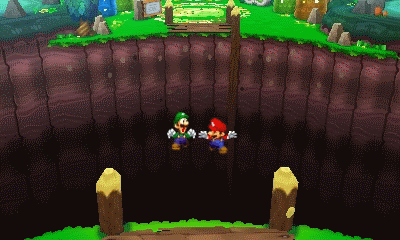 Mario and Luigi have shown up in just about every genre of game imaginable, but for one reason or another I have always tend to put my money towards platformers over their forays into RPG territory. That is part of the reason I recently picked up the Mario and Luigi themed 3DS that came prepackaged with this game. Mario and Luigi: Dream Team doesn't rely on the Mario brand to move units - it is a well polished game with a good amount of content (getting through the main story took me just shy of 30 hours).
Mario and Luigi have shown up in just about every genre of game imaginable, but for one reason or another I have always tend to put my money towards platformers over their forays into RPG territory. That is part of the reason I recently picked up the Mario and Luigi themed 3DS that came prepackaged with this game. Mario and Luigi: Dream Team doesn't rely on the Mario brand to move units - it is a well polished game with a good amount of content (getting through the main story took me just shy of 30 hours).
The gameplay is pretty straight forward, you control both Mario and Luigi together with the A button as the action button for Mario and the B button for Luigi. This dual control can be awkward at times, such as when you go to areas with many ledges and need to jump up with each of the brothers separately, but in general the game controls quite smoothly. The main gameplay "gimmick" is the ability to travel to the dream world, where battles play out differently and many interesting things can happen, particularly starring Luigi, who has a much more significant role is this game than in other Mario titles. The story is humorous and interesting, and it is coupled with great graphics that fit the feel of the game perfectly.
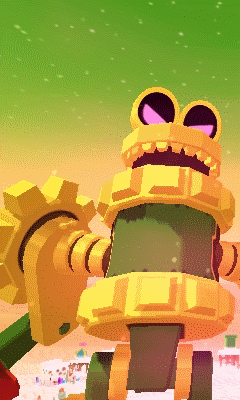
The combat is generally fun, although drawn out at time, and works using a turn based system with real time elements such as tapping a button at the right time for extra damage, or dodging enemy attacks. The brothers can attack by jumping, swinging a hammer, or using powerful "Bro's Attacks" which are unlocked over the course of the game by collecting attack pieces (as with many RPGs, there are many things to collect and obsessive completionists will find plenty to occupy them. The other thing worth mentioning are the dream world bosses. Occasionally a particularly difficult boss would get a little out of hand (see left image), resulting in a need for Luigi to amp things up a bit - these "giant Luigi battles" were easily one of the most fun elements of the game.
My main complaint about Dream Team comes from the pacing - when reading reviews before purchasing this game there were a few comments such as "avoid this game if you're not a fan of tutorials". But I brushed them off, thinking even a really bad tutorial surely couldn't last more than 30 or 45 minutes into the game. That was wrong - I was well over halfway through the game before it stopped trying to hold my hand. Actions that the majority of players will have figured out hours ago are still explained in painstaking detail. Even typing this it sounds like a minor complaint, but it is enough that I hesitate to recommend this game to all but the most patient of gamers. I found I often had to have something else going on while playing because it was just too frustrating sitting through an explanation of a simple concept for the fifth time.
Altogether, Dream Team was a well made game with good graphics, interesting characters, and fun gameplay... with one crippling flaw. So if you're expecting fast paced, stay far far away.
Earthbound
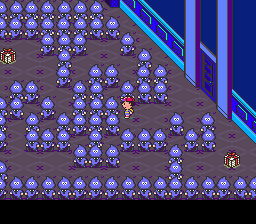
Earthbound has attained a cult following over the years, and so I decided it might be worth seeing what all the fuss was about. Additionally, I knew a variety of nerd references, not to mention Ness from the Super Smash Bros. franchise originated here. I can happily say that Earthbound did not disappoint. There were zombies, human-sized metal pencils, dinosaurs, small pink things that speak only in doodles, talking dogs, mummies, meteorites, and a final boss that I think was supposed to be the devil. So yeah... it was quite the ride.
This was a game that managed to be epic, interesting, and humorous all at once. The original, known as Mother was released only in Japan (although I believe an English port now exists), and the series did not reach North America until Mother 2 (or Earthbound). It did not sell extremely well, and in truth that doesn't surprise me - it doesn't include many characters who are well known in North America not does it fit with what you'd expect on a Nintendo console at the time.
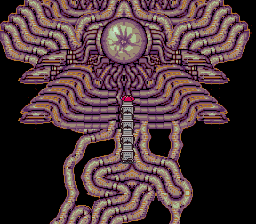
Earthbound follows Ness, who has found out he is some kind of chosen one after being instructed to hunt down an evil super-being named Giygas by a strange bee named Buzz Buzz who dies comically almost immediately after starting the plot. Ness travels to various locations, including various towns with helpful names indicating the order you should visit them (Onett, Twoson, Threed, and Fourside), a dinosaur valley, a weird cult town, a valley populated by Mr. Saturns (who have some of the most amusing dialog I've seen in a while).
Over time Ness also meets up with various traveling companions, and faces off against an inexplicably evil boy from his hometown. The final is quite strange and just begs to be analyzed on a "what were the designers getting at with that" kind of level, although I am not convinced it was intentional. All in all, Earthbound is well worth a play and I highly recommend it to anyone reading. It's earned a cult following for a reason.
Nintendo 3DS AR Games
Recently I picked up a Nintendo 3DS - I debated for a while but eventually decided that the game library looked pretty awesome and I was eager to try out some of the old handheld games on the virtual console, so I went for it. I debated between the 2DS and the 3DS XL, because I (accurately) predicted that I wouldn't care for the 3D, but I ended up going with the XL for the bigger screen and the fact that you can fold it into something that fits nicely in a jacket pocket. But this post isn't about the 3DS in general - this post is about a feature I didn't know about until I opened the box - AR games. They are AWESOME.
AR stands for augmented reality, and is a technology that I view as something of a stepping stone towards full blown virtual reality. The basic idea is that you see your everyday humdrum surroundings, and add something more. The 3DS achieves this via a set of AR cards (the 3DS comes with 6 of them, and I believe some games that use the functionality have more) that looks like this:
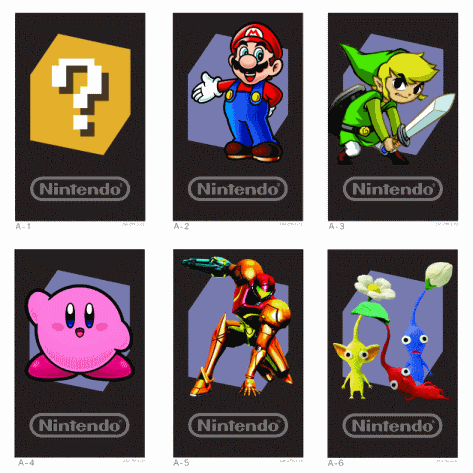
As far as I can tell, the cards themselves really aren't that important, and Nintendo could just as easily use a piece of paper with a red triangle on it as a picture of Mario. They serve as anchors so that the 3DS knows what it is looking at. When you start up the AR games section of the 3DS, it first tells you to use the question mark card and position it about 14 inches from the 3DS. It then measures the distance (the 3DS has two forward facing cameras allowing it to triangulate the distance) and starts augmenting your reality. For the first game, this involves targets appearing on, around, and even inside the surface you are playing on. The finale comes when a dragon pops out of a statue and you have to shoot it until it explodes, all while it is lunging at you leaving giant (simulated) scratch marks across your 3DS camera. It was an incredible experience and a completely unexpected one - I find it funny that my favorite 3DS feature so far is one that I didn't even know existed when I purchased it.
The games are all accessed using the question mark card, while the other 5 are used to get pictures (in 2D or 3D) with the Nintendo characters standing on them. This lets you get some awesome photos, and the coolest part is that the character that appears is proportional to the size of the card - so I can print out a giant Mario card, and come up with the following picture of Mario chilling out on my computer desk (for comparison, I've put a normal sized card of link next to him). The only thing I dislike so far is the low quality of the 3DS cameras - the photo below is the original taken with the 3DS camera, but I suspect the AR algorithms would take a lot more horsepower on high resolution images.
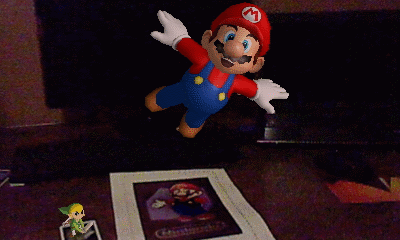
To wrap this post up, Nintendo 3DS Augmented Reality is an awesome new feature and I am looking forward to seeing how this develops with future consoles. If I can someday turn my living room into an interactive Mario platformer, I will be a happy man.
Elite Beat Agents
Have you ever wanted to travel around, helping a small group of secret agents with serious dance skills mysteriously influence events by hitting the right beats? Of course you have! And Elite Beat Agents lets you do just that. This is the sequel to a Japanse game called Osu! Tatakae! Ouedan, and fits all kinds of Japanse stereotypes. There is big hair, a giant city-wrecking cat (Meowzilla, of course), and ridiculous situations from an oil tycoon discovering Atlantis to an attack by music hating aliens. And yes, it is as fun as it sounds.
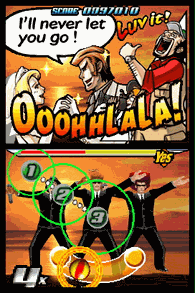
The gameplay is carried out mostly via the DS touch screen (various stuff happens on the top screen, but on any difficulty above the easiest you won't have time to watch the top screen). Basically, little numbered circles appear on the screen, and your job is to tap them in order and on the right beat. If you do so, the agents dance accordingly and a bar at the top (I believe it was called a groove meter) gets a little better. If the groove meter gets too low, horrible things happen to whoever the agents are helping (shown via mini-cutscenes), and if it reaches the bottom, you lose.
Now, fair warning - this game is HARD. However, it does difficulty right and offers something for everyone. The first difficulty mode, Breezin' is more of an introduction and it is hard to do poorly. Cruisin' gets a little bit harder, and the third difficulty level, Sweatin', becomes pretty crazy. On Sweatin' you can go through a whole song without missing a note and still lose, because you didn't hit them precisely enough (each note is worth between 50 and 300 points if you don't miss it). After every song you are given a letter rating, and despite having played several songs with no misses, I have yet to get an A, let along the top rank of S. The final difficulty, Hard Rock, lets you play as the Elite Beat Divas (listen - as a 23 year old male, this isn't the kind of game I play in public very often), and is insanely hard. If you like a challenge, this game is for you.
Elite Beat Agents is everything a rhythm game should be - it's addictive, fun, exhilarating, and has a good selection of songs (at least some of which almost everything has heard before). Sadly DS games are getting harder to find, but this one is a gem and worth tracking down if you're a fan of rhythm games, dancing, or Japanese-style zaniness.
Super Mario Bros.
Here it is - Super Mario Bros. The one that started it all. Alright, so technically Donkey Kong was the first Mario game, but this is the first one that has that famous Mario feel. It's got Goombas, Koopas, Fire Flowers, block breaking, and of course, lots of jumping. In truth, I don't find this game as fun as some of the titles that arrived shortly after like Super Mario Bros. 3 and Super Mario Land, but it is well worth playing.
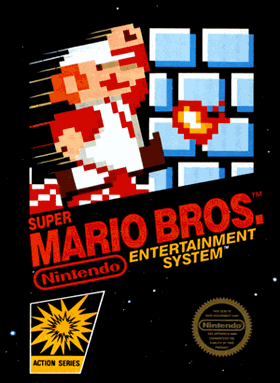
Super Mario Bros. contains 32 levels spread across 8 worlds, a size almost unknown for its time and created a whole genre of video games - the side-scroller. Each of the first 7 worlds culminates in a castle with a boss, one of the Koopalings, waiting at the end, and of course in each castle we hear the famous line: "Thank you Mario, but our princess is in another castle." There is not much else to say about Super Mario Bros - it catapulted the producer, Shigeru Miyamoto, into fame that lasts to this day, created the Mushroom Kingdom where countless adventures have been had, and was an integral part of the childhoods of an entire generation.
Super Mario Land 2
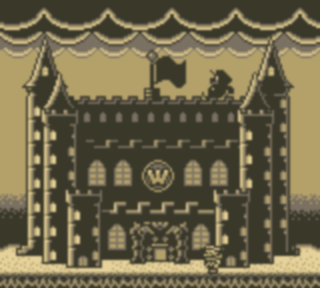
Reviewing Super Mario Land, I found the game enjoyable but not particularly noteworthy. I am happy to say that this was not at all the case for its sequel. Despite still being on the Game Boy, in four odd shades of green-gray, the graphics managed to feel well done and artistic, in contrast to the almost comically poor visuals in the first, and the story was top notch. Mario must go through six zones to collect six coins to reach the final villain - Wario in his first appearance ever. The sound continued to impress, the game was fun, the coin mechanism was fun (coins are saved up to use to play the slots for lives and power ups) and a bunny ear power up allowed Mario to fly, and flying power ups always feel the most fun to me.
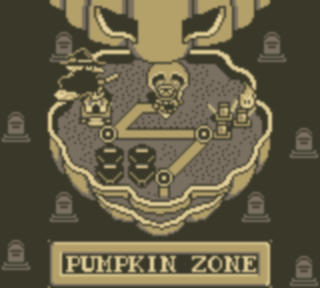
In many ways, Super Mario Land 2 doesn't feel like a Mario game. Similar to the first game, the enemies are largely unfamiliar, although Koopa Troopas and Goombas are present, there is no overall score, and especially striking is the lack of a princess to save. The style of Gunpei Yokoi, producer of the Super Mario Land games is markedly different from that of Shigeru Miyamoto, famous for... just about everything else Mario, but he does the franchise justice. The six zones (as opposed to worlds in other Mario games) are imaginative and each one feels so different that I found myself looking forward to seeing the next landscape. The zone themes are also unusual and include space, halloween, clockwork mario, and of course the dark castle of Wario with thunderbolts crackling overhead. In addition, in general the difficulty feels just a tad easier than the first, which to me was a nice change - too many deaths and I begin to get frustrated and the game stops flowing. An exception, unfortunately, is the final castle which is quite difficult and unless you are lucky enough to beat Wario in one go, needs to be traversed many times.
Going from not having heard of the Super Mario Land series to playing this game feels like digging up an undiscovered gem, and is thus far my favourite game on my quest to the roots of gaming (although the quest has just begun). If you have a 3DS, this game is available on the virtual console for $3.99 and it's worth every penny.
Super Mario Land
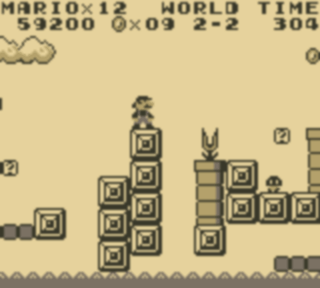
In the prelude to my video game adventure, I named the Gamecube as the first video game system I was able to use. This is not exactly true - when I was somewhat younger I was given a Game Boy by my grandpa with Tetris on it. I don't have a lot of memories of it (with the exception of Theme A and Theme B forever being burned into my mind) but I know it was fun. That is why it was a bit of a surprise to read about Super Mario Land, the first portable Mario offering. Even while owning a Game Boy, I was completely unaware of the existence of this game.
So, having spent the last few days playing through to the final boss, I figured it warranted a post. This is basically what you would expect from a Mario game. 12 levels spread over 4 worlds with koopa troopas, goombas, wasps with spears (?), and other strange enemies with gameplay consisting of a lot of running and jumping. It was enjoyable to play through, although I feel I am unlikely to come back to it in the future. Visuals, while not usually a major concern of mine (I'm playing through games from the 80s and 90s and blogging about it), the original Game Boy does give me some trouble. Undoubtedly it was amazing in 1989, but after playing side scrolling Mario games on the DS and Wii, this feels a little bit too primitive. It is certainly worth a play for the history, but if you are one to get hung up on graphics, do not pick this up. That being said, the sound is very impressive for such an early title, and I found the music from the first boss level familiar (and barely changed) from the soundtrack of the much more recent Super Smash Bros. Brawl.
Also interesting is the use of Daisy as the damsel to save. I didn't know the origin of Daisy as a character, but I guess this must be it. It is probably an attempt to set this apart from other Mario games, as this is supposed to be set in a place called Sarasaland, instead of the usual Mushroom Kingdom. There is also a twist on the "Your princess is in another castle" gag from the NES game, where after each boss, Daisy appears but then is revealed to actually be an enemy. All in all, Super Mario Land was a fun look at the beginnings of the Nintendo portables and I am looking forward to playing the sequel.
Donkey Kong
A quest to explore the history of video games would not be complete with playing Donkey Kong. In the 1980s, Nintendo began trying to expland into the North American market with Radar Scope - a space shooter that had been selling well in Japan. However, they did not sell in America and Nintendo was left was a boatload of unused, expensive, arcade cabinets. They decide to convert them into something else, and that something else was Donkey Kong, designed by a young Shigeru Miyamoto. The cabinets were converted, the game sold like wildfire, and the rest is history. You'd be hard pressed to find a man, woman, or child in North America who didn't know Mario's face.
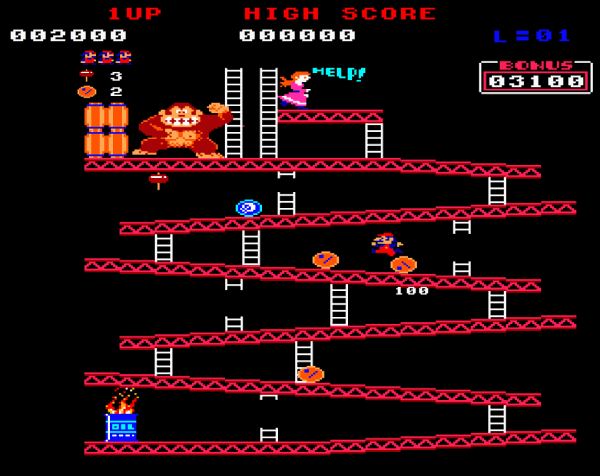
The game itself is charming, and carries a lot of nostalgia value for any Nintendo fan, even if they haven't played it before. I was familiar with the levels simply because it's hard to be a gamer without running into remakes and satires and all manner of art based off them. It's a simple concept - Donkey Kong has stolen Lady (a.k.a. Pauline) and Mario must climb a treacherous tower to get her back. The controls take a moment to get used to, lacking the fluid feel of modern games, and the sound is very primitive, but that is all part of the experience.
Giving a rating or even general thoughts to this game feels like a futile exercise. History has judged Donkey Kong a success, and I'm not one to argue with history.